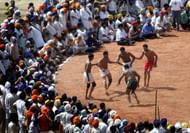It’s just a few hours to go before stadiums across India start reverberating with the chants of ‘Kabaddi, Kabaddi.’ The battle of belligerent raiders taking on resolute defenders will leave the spectators spellbound as the fifth season of the very popular Pro Kabaddi League (PKL) kicks off.
For the past four seasons, the sport has mesmerized the audience, bringing in more fans. The simplistic and easy-to-learn nature of this particular combat sport has definitely been one of the myriad reasons for its sky-high popularity. The PKL has left an indelible impression on India’s sports lovers by bridging the gap between the urban and the rural population.
India’s inextricable bond with kabaddi
Perhaps, its biggest success has been reviving an age-old sport whose roots can be traced back to Indian mythology. It is a sport that has been firmly entrenched in the Indian soil for centuries.
The game is said to have had its inception in the southern state of Tamil Nadu. Even the word ‘kabaddi’ owes its origin to the Tamil word, ‘kai-pidi’, which means holding hands.
The country not only gave birth to the sport but also made it a staple sport amongst the youth for the purpose of developing their physical strength and reflex actions.
Group sports were a common affair in pre-historic times and kabaddi is what helped them boost their alertness, defence and aggression. Erstwhile princes of the country would thus indulge in this sport to make a proud display of their vigour and strength.
Kabaddi in Mahabharata
The most noteworthy mention of kabaddi, however, is found in the Hindu mythological epic, ‘The Mahabharata’. Legend has it that the Pandava warrior Arjuna picked up the skills of Kabaddi under the tutelage of Lord Krishna. He mastered the art of quietly sneaking into enemy traps and demolishing the fortifications without a single scratch on his body.
The epic also talks of the tragic death of Arjuna’s son, Abhimanyu, who was successful in piercing the ‘Chakravyuha’ or the seven-tiered defensive wall of the Kauravas during the Kurukshetra War but did not know the way out.
It is said that Abhimanyu learned the technique of attacking when he was a fetus in Devi Subhadra’s womb by absorbing his father, Arjuna’s narration to his mother. But Arjuna was called by Krishna and the conversation had to stop, depriving the unborn Abhimanyu the knowledge of escape from the deadly formation.
On the 13th day of the Kurukshetra battle, the 16-year-old Abhimanyu broke through the Kaurava formation in a scintillating show of valour and fearlessness. The teenager fought gallantly but ultimately was mercilessly killed by the enemy brigade as he could not escape from their iron clutches.
Ancient scripts suggest that the sport of kabaddi was established in memory of the courageous fighter that Abhimanyu was.
Kabaddi in Buddhist literature
The mention of kabaddi can also be found in Buddhist literature which proves further that the sport has always been adored and practised with a lot of gusto in ancient India. Lord Gautam Buddha was one of the early ambassadors of the sport and religiously played it with his peers.
Kabaddi in different parts of India

From these early times, kabaddi has seeped into the tradition of modern India. It earned itself different names in various regions of the country. In Tamil Nadu, it is prevalent as kabaddi or ‘chadukudu’, in Andhra Pradesh, it got the name, ‘chedugudu’. In the north in Punjab, it is common as ‘kauddi’ and in the eastern part of the country, it got popularised as ‘hu-tu-tu’.
Even in Bangladesh and Maldives, the sport has equal importance and is known as ‘hadudu’ and ‘bhavatik’ respectively.
Modern kabaddi, as we know it, is a synthesis of all these forms.
With such a rich heritage and history, it was thus not a surprise that the sport was bestowed upon the honour of the national sport in 1918. It was then that the first baby-steps were taken to make kabaddi a mainstream sport.
The first rules and regulations were formulated in 1918 itself before being printed five years later in 1923. It was that same year that the first All India Kabaddi Tournament was organized at Baroda.
With a steady influx of players and regular staging of national-level tournaments, the game pervaded throughout the country. India thus became a major powerhouse of the sport and getting it international exposure was the next natural course of action.
Kabaddi’s tryst with Hitler and the Olympics
A little-known educational institute in Amravati called the Hanuman Vyayam Prasarak Mandal (HVPM) gave kabaddi its first documented international exposure in Berlin in the Hitler regime. A 35-member contingent from the institute was invited to the German city in 1936 to give demonstrations of mallakhamb and kabaddi.
The team performed spectacularly at the Congress of Physical Education in Berlin right before the mega quadrennial Games. The audience was captivated by the Indian martial art forms and their display was given rave reviews by most of the regional European papers of that time.
Word spread and it reached the ears of Hitler’s Propaganda Minister Joseph Goebbels, who convinced the Fuhrer to grant the contingent a 20-minute audience. They were presented with a medal on the concluding day of the Berlin Olympics.
The AIKF and AKFI and their roles
While that remains kabaddi’s most significant brush with the Olympics, at home there were tireless efforts going on through the years to give the sport its due recognition. In 1938, the game was introduced in the Indian Olympics Games, which was the nascent form of the Indian National Games.
Kabaddi got a major fillip with the All India Kabaddi Federation (AIKF) coming into existence in 1950. They were responsible for promoting the sport actively and began the National level kabaddi championships in 1952. They took it a level further in 1955 when they organized the first men's national tournament and the women’s national tournaments separately in Chennai and Kolkata respectively.
The AIKF was rechristened as the Amateur Kabaddi Federation of India (AKFI) in 1972 with a focus on promoting the game in India’s neighbouring countries.
The initiative was successful and they could give kabaddi a platform in Japan in 1979 during a tour of the country.
Kabaddi in modern times

Their efforts were reflected in the first Asian Kabaddi Championship that was held in 1980 where Japan, Nepal, Malaysia participated along with India and Bangladesh. India emerged the champions by prevailing over Bangladesh, whose national game is kabaddi.
It also began India’s intimidating domination over other countries in major tournaments.
The burgeoning popularity of the game paved the way for its introduction at the Asian Games in Beijing in 1990 and that gave kabaddi a major foothold in the sports realm.
Over the years, kabaddi has rightfully earned its place in school and university sports curriculums all over India. That itself has been a big step in inculcating the benefits of kabaddi in young kids and in motivating them to pursue the sport extensively.
With kabaddi catching the fancy of the masses, it also got featured in many notable films, namely, Little Buddha, Pardes, Hu Tu Tu, Okkadu, Vennila Kabadi Kuzhu, Bheemli Kabaddi Jattu, Badlapur Boys and Tevar, among others.
Today, the game is pursued widely all over the world. India definitely has been the torchbearer of this sport but it is played with equal fervour in Bangladesh, Japan, Sri Lanka, Iran, Korea, Thailand, Malaysia, China, Trinidad and Tobago, Australia, Canada, United Kingdom, Indonesia and many more countries.
With the founding of the PKL in 2014, the sport has simply exploded. The glitz and glamour, the razzmatazz, the branding, the packaging - all the ingredients have been blended well to make kabaddi a sport that everybody can readily connect to, building an even brighter future for the game and its exponents.
